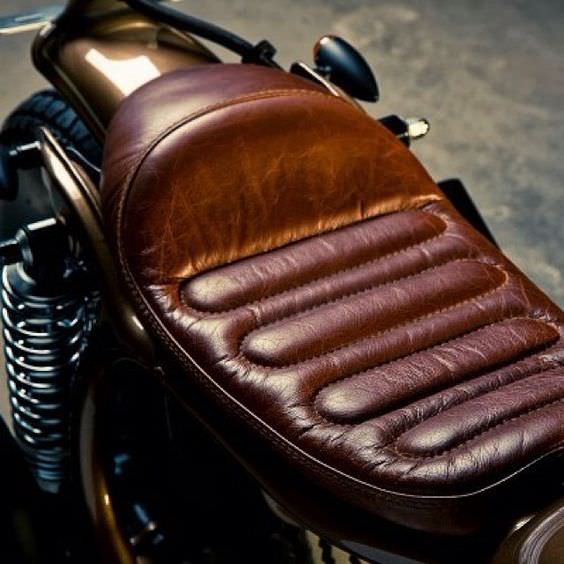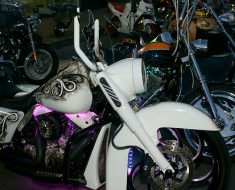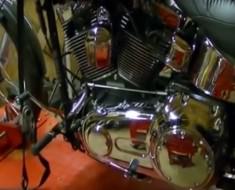You’ve probably noticed seat height measurements mentioned in nearly every motorcycle review. But why is seat height so important, and how should it affect your decision making when it’s time to choose a bike?
Here’s an overview of everything you need to know about seat height—from why the figure differs from bike-to-bike, to what you should look for when you’re trying on a motorcycle for size, and ways to work around a bike’s tall saddle.
What Exactly is Seat Height?
Seat height is the measurement (usually in millimeters or inches) from the lowest point of a motorcycle’s saddle to the ground, with the bike positioned upright (ie, not on its side stand or center stand.) But the figure can vary depending on suspension settings; for instance, if the bike is setup with more preload, it can sit taller and settle less when a rider rests his or her weight on the saddle.
The easiest way to relate seat height to body type is inseam measurement, which is the distance between your crotch and the ground.

How Does Bike Type Affects Seat Height?
Saddles come in a wide variety of shapes, sizes, and heights, because each type of motorcycle has a different purpose—and therefore, function. As a direct result of a bike’s engineering and styling variables, motorcycle saddles take on different shapes which affect the rider’s ability to reach the ground.
Cruisers tend to have the lowest seat heights, since their engines are usually narrow inline v-twins which sit ahead of the rider, leaving plenty of room for the saddle to be positioned closer to the ground.
Sportbikes typically have taller saddles, primarily because greater ground clearance allows the bike can lean over more in turns.
Transversely-mounted, multi-cylinder engines common to sportbikes can also create tighter packaging, which forces higher seat placement.
Offroad, dual purpose, and supermoto bikes have increased suspension travel, which can do a great job of smoothing out surface irregularities. But greater suspension travel also raises the overall elevation of the bike, and naturally, the saddle. But as you’ll see below, you shouldn’t always take seat height ratings on offroad bikes at face value.
It’s Not Just the Height of the Seat, it’s the Shape of the Saddle
It’s easy to obsess over numbers on a spec sheet, and motorcycle manufacturers often use seat height figures as a sales tactic since lower numbers open the door for more potential buyers. Some manufacturers even have a filter on their websites that highlight bikes with the lowest seat heights—but sometimes the figure only tells half the story.
Offroad bikes have narrow saddles, which enable greater leg extension. Though their seats are tall, those seat height figures can be a bit misleading because their narrow saddles actually make it easier to touch pavement.
On the other hand, sportbikes often have wider saddles because the rider sits over a transversely configured, multi-cylinder engine, which necessitates a wider surface. The width usually makes it harder to reach the ground because the rider’s legs have to stretch around the saddle’s large, flat area.
The lesson here? Take seat height figures with a grain of salt, since there’s no substitute for actually sitting on a motorcycle and finding out how easy it is to touch the ground.

How High is Too High?
There’s a certain reassurance to feeling both feet planted firmly on pavement at a stoplight, but it’s definitely more of a luxury than a necessity. Your choice of bike should be all about your personal comfort level, and the best way to explore that is to actually sit on the bikes in question and see how they feel.
You’ll notice that the bike’s weight has a big effect on how easy it is to keep upright; if a bike is light, you might be able to hold it up while standing on the tips of your toes. Heavier bikes might require you to stand with a flat foot. If you sample a bike on level ground, you should also keep in mind that stopping or parking on uneven pavement (or where the road has a “crown”, ie slopes on the sides) will require additional reach.
At the end of the day, there’s no magic formula for seat height selection; it’s an individual preference that’s best gauged by your comfort level and personal taste.
I’m a Shorter Rider; What Can I Do to Reach the Ground More Easily?
Shorter riders will notice that their choice of foot protection affects their ability to touch the ground; not only do boots offer more crash protection, their thick soles will help to make contact with pavement.
Another way to maximize your leg reach is to steer your bike away from the side on which you’re going to put a leg down. That way, the motorcycle will tilt slightly and you’ll be able to effectively form a tripod that allows for a stable stop until it’s time to get rolling again.
There’s also a good chance an accessory saddle is available for your bike which will lower your altitude and make it easier to touch the ground.
What About Suspension Lowering?
Many riders are quick to lower their bike’s suspension without a second thought. But in addition to changing ground clearance, dropping your suspension also affects cornering clearance, shock compression, wheel travel, and suspension geometry—all of which usually translates to worse handling. Though it’s not impossible to lower a bike and anticipate unusual handling characteristics, it’s advisable to avoid suspension modification and find other ways to address the issue of seat height.
(Source)








